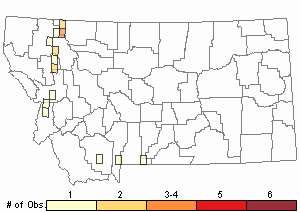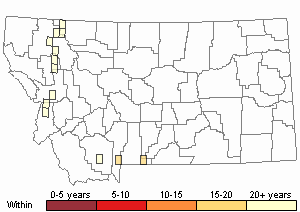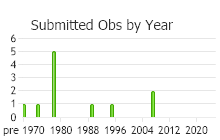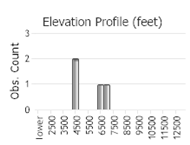View in other NatureServe Network Field Guides
NatureServe
Montana
Utah
Wyoming
Idaho
Wisconsin
British Columbia
South Carolina
Yukon
California
New York
Norwegian Syntrichia Moss - Syntrichia norvegica
Other Names:
Norwegian Twist Moss,
Tortula norvegica
General Description
Plants: Acrocarpous (Vitt 1988). Growing in thick, loose clumps with erect stems, deep green touched with red hues above, typically reddish below. Stems 1-10 cm in height, not possessing a central strand (Flowers 1973).
Leaves: Leaves nearly flattened to the stem, folded longitudinally, and frequently contorted a little when dry, spreading about 90 degrees with the tips turned downwards (squarrose-recurved) when wet, concave, oblong and spatula- to strap-shaped (lanceolate or broadly so toward the bottom in some forms); apex obtuse and gently rounded to sometimes narrowly acute (Flowers 1973); margins unbordered, rolled back to above the middle (Lawton 1971), flat in the apical 1/3; costa sturdy, excurrent to form a hair-point; hair-point red, smooth to minutely toothed with papillae (Flowers 1973) at the back, still looking glossy and smooth under a stereoscope (Crum and Anderson 1981), its bottom frequently broad and decurrent with the leaf apex (Flowers 1973).
Leaf Cells: Apical cells frequently fine-walled, polygonal, deep green, coarsely roughened, occasionally with stellate papillae (Flowers 1973) but usually thickly covered with C-shaped papillae on both faces (Crum and Anderson 1981); basal laminal cells longer than the apical cells, not papillose, hyaline; basal marginal cells short, green or red. Leaves toward the base frequently erect (Flowers 1973).
Diagnostic Characteristics
T. norvegica and T. ruralis may intergrade a little (Flowers 1973), but they are fairly well separated (Crum and Anderson 1981; Flowers 1973). The Norwegian Tortula Moss is distinguished by its smooth costa and the nearly smooth, red, glossy awn. The awn of T. ruralis is usually red only at the base (rarely to the distal end) and the rest of the costa, as well as the awn, is obviously roughened (Crum and Anderson 1981). The amount of red color, however, apparently changes with shade, and is thus not conclusive (FNA 2007).
Range Comments
Broadly distributed in western North America (Flowers 1973), from CA to the Aleutian Islands and AK, running inland to AB through CO (Crum and Anderson 1981) and NM (Lawton 1971); disjunct in MI (Crum and Anderson 1981). Also in Greenland, Europe, and North Africa (Flowers 1973).
Observations in Montana Natural Heritage Program Database
Number of Observations: 19
(Click on the following maps and charts to see full sized version)
Map Help and Descriptions
Relative Density

Recency



 (Observations spanning multiple months or years are excluded from time charts)
(Observations spanning multiple months or years are excluded from time charts)
Habitat
Calcareous soil and rock (Crum and Anderson 1981) and rock crevices (Flowers 1973); also reported from moist granitic rocks (Weber 1973). Mostly montane to alpine (Flowers 1973), and associated with late snows (Vitt 1988).
Reproductive Characteristics
Dioicous. Setae 10-20 mm in length (Flowers 1973), flexuose when dry, reddish. Capsules russet, widely cylindric, straight or slightly rounded, 2-3 mm in length; operculum tall and cone-shaped, 1.5-1.8 mm in length; peristome pinkish-orange, the upper portion spiraled, the basal tube lighter and tiled (Crum and Anderson 1981).
Stewardship Responsibility
References
- Literature Cited AboveLegend:
 View Online Publication
View Online Publication Crum, H.A. and L.E. Anderson. 1981. Mosses of Eastern North America. 2 volumes. Columbia University Press, New York. 1328 pp.
Crum, H.A. and L.E. Anderson. 1981. Mosses of Eastern North America. 2 volumes. Columbia University Press, New York. 1328 pp. Elliott, J.C. and A.K. Pipp. 2018. A Checklist of Montana Mosses (1880-2018). Updated 3 January, 2020. Montana Natural Heritage Program, Helena, Montana. 73 pp.
Elliott, J.C. and A.K. Pipp. 2018. A Checklist of Montana Mosses (1880-2018). Updated 3 January, 2020. Montana Natural Heritage Program, Helena, Montana. 73 pp. Flora of North America Editorial Committee, eds. 2007. Flora of North America North of Mexico. Volume 27. Bryophytes: Mosses, Part 1. Oxford University Press, Inc., NY. xxi + 713 pp.
Flora of North America Editorial Committee, eds. 2007. Flora of North America North of Mexico. Volume 27. Bryophytes: Mosses, Part 1. Oxford University Press, Inc., NY. xxi + 713 pp. Flowers, S. 1973. Mosses: Utah and the West. Brigham Young University, Provo, Utah. 567 p.
Flowers, S. 1973. Mosses: Utah and the West. Brigham Young University, Provo, Utah. 567 p. Lawton, E. 1971. Moss Flora of the Pacific Northwest. Hattori Botanical Laboratory. Japan: Yamabuki-cho, Shinjuku-ku, Tokyo. 362 pages plus appendices.
Lawton, E. 1971. Moss Flora of the Pacific Northwest. Hattori Botanical Laboratory. Japan: Yamabuki-cho, Shinjuku-ku, Tokyo. 362 pages plus appendices. Smith, A.J.E. 1980. The Moss Flora of Britain and Ireland. Cambridge University Press, Cambridge. 705 pp.
Smith, A.J.E. 1980. The Moss Flora of Britain and Ireland. Cambridge University Press, Cambridge. 705 pp. Vitt, D. J. Marsh, and R. Bovey. 1988. Mosses, Lichens & Ferns of Northwest North America. Seattle, WA: University of Washington Press. 296 p.
Vitt, D. J. Marsh, and R. Bovey. 1988. Mosses, Lichens & Ferns of Northwest North America. Seattle, WA: University of Washington Press. 296 p. Weber, W. A. 1973. Guide to the Mosses of Colorado. Boulder, CO: University of Colorado, Institute of Arctic and Alpine Research Occasional Paper 6. iii + 48 pp.
Weber, W. A. 1973. Guide to the Mosses of Colorado. Boulder, CO: University of Colorado, Institute of Arctic and Alpine Research Occasional Paper 6. iii + 48 pp.
- Additional ReferencesLegend:
 View Online Publication
View Online Publication
Do you know of a citation we're missing? Elliot, J. C. 1993. Second checklist of Montana mosses. Unpublished report. U.S. Forest Service, Region 1. Missoula, MT. 45 pp.
Elliot, J. C. 1993. Second checklist of Montana mosses. Unpublished report. U.S. Forest Service, Region 1. Missoula, MT. 45 pp. Lawton, E. 1971. Keys for the Identification of the Mosses on the Pacific Northwest. Reprinted from 'Moss Flora of the Pacific Northwest'. Published as Supplement No. 2 of the Journal of the Hattori Botanical Laboratory. Nichinan, Miyazaki, Japan. 66 pp.
Lawton, E. 1971. Keys for the Identification of the Mosses on the Pacific Northwest. Reprinted from 'Moss Flora of the Pacific Northwest'. Published as Supplement No. 2 of the Journal of the Hattori Botanical Laboratory. Nichinan, Miyazaki, Japan. 66 pp.
- Web Search Engines for Articles on "Norwegian Syntrichia Moss"





